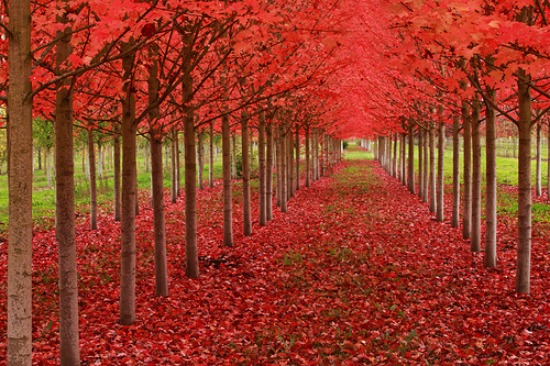The Trouble With Trees
Here are 10 things scientists have learned about trees this year. Thanks to climate change, it’s not a pretty picture.
![]()
It’s the time of year when trees refuse to be ignored. Behold our fabulous hues, ponder our falling leaves, they goad us. And many of us do pay attention for a bit, only to lose interest when the show is over.
We know the cycle will begin again next spring and peak again in the fall, trees being one of the truer things in modern life. I mean, what’s more reliable than an oak?
But scientists will tell you that, like the oceans, the world’s trees are going through some serious changes, and not in a good way.
A dry run
Consider the impact of the drought that’s been desiccating America’s Southwest. Two weeks ago, the Texas A&M Forest Service issued a damage report: More than 300 million trees died in Texas forests alone as a result of the 2011 drought. It killed another 5.6 million trees in Texas cities.
Then last week a study published in Nature Climate Change concluded that if current climate trends continue, forests in the Southwest will die out at an accelerating rate. And not just from rising temperatures and lack of rain, but also from invasions of tree-eating pests and more destructive forest fires, also tied to climate change.
For instance, by analyzing forest fire data from satellites for the past 30 years in parallel with data on tree ring growth over the same period, the researchers were able to see a “strong and exponential” relationship between droughts and the number of acres of forests wiped out by wildfires.
Notes A. Park Williams, a scientist at the Los Alamos National Laboratory in New Mexico and lead author of the study: “This suggests that if drought intensifies, we can expect forests not only to grow more slowly, but also to die more quickly.”
Computer models suggest that for 80 percent of the years in the second half of the 21st century, America’s Southwest will suffer through what the study describes as “mega-drought.”
In the spirit of giving trees more than a seasonal glance, here are 10 other things scientists have learned about them this year.
1) Forest fires have become more intense and harder to control. One big factor is the rising frequency of what are known as “blowdowns.” With violent storms with strong winds occurring more often, whole sections of forests are toppling over, creating, in essence, giant campfires awaiting a spark.
2) And the death of forests could double the number of big floods. A study at the University of British Columbia concluded that faster snow melts due to fewer trees creating shade will not only increase the size of floods, but could also make the really big ones happen more often.
3) Sick trees could be boosting greenhouse gas levels. Scientists at Yale University found that diseased trees can carry very high levels of methane, one of the more potent greenhouse gases. Although they appear healthy, many old trees–between 80 and 100 years old–are being hollowed out by a fungal infection that slowly eats through the trunk, creating a nice home for methane-producing microorganisms.
4) On a brighter note, palm trees once grew in Antarctica. Okay, it was 53 million years ago, back when Antarctica was still connected to Australia, but researchers drilling deep beneath the sea floor off the eastern coast of the now-frozen continent, found pollen grains from palm and macadamia trees. Scientists estimate that back then, high summer temperatures there could reach the upper 70s.
5) A handful of trees can tell the rainfall history of the Amazon. Based on measurements of oxygen isotopes trapped within the rings of only eight cedar trees in Bolivia, scientists at the University of Leeds in Great Britain say they can tell how much it has rained over the entire Amazon basin during the past century.
6) NASA technology could help save trees that look risky. The space agency is using high-tech cameras to create 3-D images of trees, a process that will help experts get a better idea of where a tree is likely to crack and how it might come down. Ideally, this could help save trees that arborists now would probably cut down.
7) Will it be smarter to grow smaller trees? Scientists at Oregon State University think so. They believe it will make sense to grow genetically-modified “semi-dwarf” trees in the future to make them better suited for drier climates and as a source of bioenergy.
8) Slow down on the maple syrup. The U.S. Forest Service says that climate change is likely to diminish production of maple syrup later this century. The reason? Habitats suitable for maple trees are expected to shrink.
9) Fossilized forests could come back to life. Forests in the Canadian Arctic that last were alive more than 2.5 million years ago could be revitalized by climate change, according to a University of Montreal scientist. Alexandre Guertin-Pasquier says that, according to climate change forecasts, temperatures could rise to levels similar to when willow, pine and spruce trees thrived in now snow-covered places such as Bylot Island.
10) Good trees make good neighbors? Studies in three American cities–Baltimore, Philadelphia and Portland, Ore.–concluded that urban neighborhoods with more trees tend to have lower crime rates. While no researcher would go so far as to say that trees reduce crime, they did find a “very strong association” between more tree canopy and less crime.
Video bonus: In case you think I’ve spent way too much time talking about trees, sit back and watch a year in the life of forest go by in two minutes.
More from Smithsonian.com
/https://tf-cmsv2-smithsonianmag-media.s3.amazonaws.com/accounts/headshot/randy-rieland-240.png)

/https://tf-cmsv2-smithsonianmag-media.s3.amazonaws.com/accounts/headshot/randy-rieland-240.png)